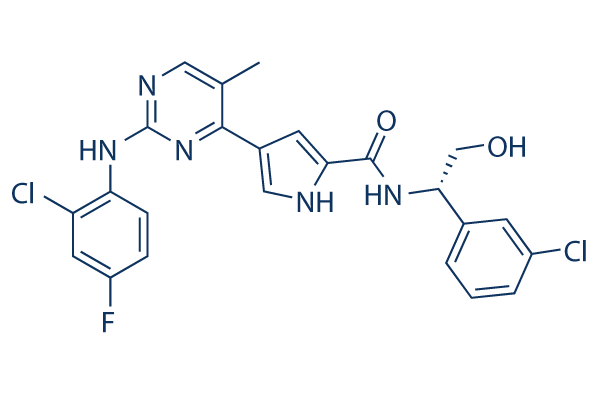All AbMole products are for research use only, cannot be used for human consumption.

In vitro: In HT29 cells, VX-11e potently inhibits cell proliferation with IC50 of 48 nM.
In vivo: In both rats and mice, VX-11e shows good oral bioavailability. In NSG mice bearing human melanoma RPDX tumors, VX-11e (50 mg/kg, p.o.) results in robust inhibition of pRSK, and inhibits tumor growth. When used in combination with BKM120, VX-11e results in significantly improved tumor growth inhibition.
| Cell Experiment | |
|---|---|
| Cell lines | HT29 cells |
| Preparation method | Cell proliferation is measured by 3H-thymidine incorporation. The cells are plated at a concentration of 10,000 cells/well in a 96-well plate using growth media, RPMI 1640 containing 10% FBS. Serially diluted compounds are added. The cells and compounds are incubated for 48 hours at 37°C incubator. After 48 hours, 0.4 μCi of 3H-thymidine is added to each wells for 8 hours and returned to the 37°C incubator. The cells are harvested using a Tomtec 96-well cell harvester and the CPM is determined using the Wallac 1205 BETAPLATE liquid scintillation counter. The IC50 is the 50% inhibition of contr |
| Concentrations | ~10 μM |
| Incubation time | 48 h |
| Animal Experiment | |
|---|---|
| Animal models | NSG mice bearing human melanoma RPDX tumors |
| Formulation | 5% ethanol, 20% propylene glycol, 7.4% Tween80 |
| Dosages | 50 mg/kg BID |
| Administration | p.o. |
| Molecular Weight | 500.35 |
| Formula | C24H20Cl2FN5O2 |
| CAS Number | 896720-20-0 |
| Solubility (25°C) | DMSO ≥ 60 mg/mL |
| Storage |
Powder -20°C 3 years ; 4°C 2 years In solvent -80°C 6 months ; -20°C 1 month |
| Related ERK Products |
|---|
| ERK Inhibitor II (Negative control)
ERK Inhibitor II (Negative control) is an effective inhibitor of extracellular signal-regulated kinase (ERK). |
| PACAP-38 (31-38), human, mouse, rat
PACAP-38 (31-38), human, mouse, rat is a PAC1 receptor activator and increases the α-secretase activity. |
| Endothelin-1 (1-31) (Human)
Endothelin-1 (1-31) (Human) is a potent vasoconstrictor and hypertensive agent. |
| ZINC12409120
ZINC12409120 is a high selective ERK inhibitor. |
| Tizaterkib (hexanedioic acid)
Tizaterkib hexanedioic acid is a potent and selective ERK2 inhibitor, with an IC50 of 0.6 nM. |
All AbMole products are for research use only, cannot be used for human consumption or veterinary use. We do not provide products or services to individuals. Please comply with the intended use and do not use AbMole products for any other purpose.


Products are for research use only. Not for human use. We do not sell to patients.
© Copyright 2010-2024 AbMole BioScience. All Rights Reserved.
